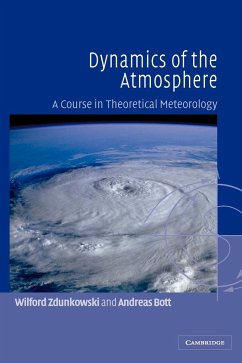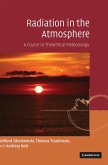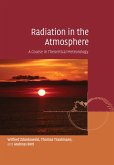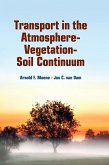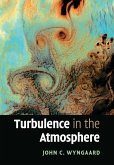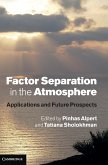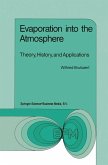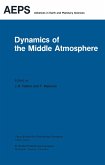W. Zdunkowski, Andreas Bott, Wilford Zdunkowski
Dynamics of the Atmosphere
A Course in Theoretical Meteorology
W. Zdunkowski, Andreas Bott, Wilford Zdunkowski
Dynamics of the Atmosphere
A Course in Theoretical Meteorology
- Gebundenes Buch
- Merkliste
- Auf die Merkliste
- Bewerten Bewerten
- Teilen
- Produkt teilen
- Produkterinnerung
- Produkterinnerung
A graduate-level text book for students in meteorology, containing numerous exercise sets and solutions.
Andere Kunden interessierten sich auch für
![Radiation in the Atmosphere Radiation in the Atmosphere]() Wilford ZdunkowskiRadiation in the Atmosphere168,99 €
Wilford ZdunkowskiRadiation in the Atmosphere168,99 €![Radiation in the Atmosphere Radiation in the Atmosphere]() Wilford ZdunkowskiRadiation in the Atmosphere50,99 €
Wilford ZdunkowskiRadiation in the Atmosphere50,99 €![Transport in the Atmosphere-Vegetation-Soil Continuum Transport in the Atmosphere-Vegetation-Soil Continuum]() Arnold F. MoeneTransport in the Atmosphere-Vegetation-Soil Continuum82,99 €
Arnold F. MoeneTransport in the Atmosphere-Vegetation-Soil Continuum82,99 €![Turbulence in the Atmosphere Turbulence in the Atmosphere]() John C. WyngaardTurbulence in the Atmosphere45,99 €
John C. WyngaardTurbulence in the Atmosphere45,99 €![Factor Separation in the Atmosphere Factor Separation in the Atmosphere]() Factor Separation in the Atmosphere151,99 €
Factor Separation in the Atmosphere151,99 €![Evaporation into the Atmosphere Evaporation into the Atmosphere]() W. BrutsaertEvaporation into the Atmosphere153,99 €
W. BrutsaertEvaporation into the Atmosphere153,99 €![Dynamics of the Middle Atmosphere Dynamics of the Middle Atmosphere]() Dynamics of the Middle Atmosphere39,99 €
Dynamics of the Middle Atmosphere39,99 €-
-
-
A graduate-level text book for students in meteorology, containing numerous exercise sets and solutions.
Hinweis: Dieser Artikel kann nur an eine deutsche Lieferadresse ausgeliefert werden.
Hinweis: Dieser Artikel kann nur an eine deutsche Lieferadresse ausgeliefert werden.
Produktdetails
- Produktdetails
- Verlag: Cambridge University Press
- Seitenzahl: 738
- Erscheinungstermin: 26. April 2011
- Englisch
- Abmessung: 260mm x 183mm x 44mm
- Gewicht: 1558g
- ISBN-13: 9780521809498
- ISBN-10: 0521809495
- Artikelnr.: 29338189
- Herstellerkennzeichnung
- Libri GmbH
- Europaallee 1
- 36244 Bad Hersfeld
- gpsr@libri.de
- Verlag: Cambridge University Press
- Seitenzahl: 738
- Erscheinungstermin: 26. April 2011
- Englisch
- Abmessung: 260mm x 183mm x 44mm
- Gewicht: 1558g
- ISBN-13: 9780521809498
- ISBN-10: 0521809495
- Artikelnr.: 29338189
- Herstellerkennzeichnung
- Libri GmbH
- Europaallee 1
- 36244 Bad Hersfeld
- gpsr@libri.de
Preface
M1. Algebra of vectors
M2. Vector functions
M3. Differential relations
M4. Coordinate transformations
M5. The method of covariant differentiation
M6. Integral operations
M7. Introduction to the concepts of nonlinear dynamics
1. The laws of atmospheric motion
2. Scale analysis
3. The material and the local description of flow
4. Atmospheric flow fields
5. The Navier-Stokes stress tensor
6. The Helmholtz theorem
7. Kinematics of two-dimensional flow
8. Natural coordinates
9. Boundary surfaces and boundary conditions
10. Circulation and vorticity theorems
11. Turbulent systems
12. An excursion into the spectral turbulence theory
13. The atmospheric boundary-layer
14. Wave motion in the atmosphere
15. The barotropic model
16. Rossby waves
17. Inertial and dynamic stability
18. The equation of motion in general coordinate systems
19. The geographical coordinate system
20. The stereographic coordinate system
21. Orography-following coordinate systems
22. The stereographic system with a generalised vertical coordinate
23. A quasi-geostrophic baroclinic model
24. A two-level prognostic model: baroclinic instability
25. An excursion into numerical procedures
26. Modeling of atmospheric flow by spectral techniques
27. Predictability
Answers to problems
List of commonly used symbols
References
Index.
M1. Algebra of vectors
M2. Vector functions
M3. Differential relations
M4. Coordinate transformations
M5. The method of covariant differentiation
M6. Integral operations
M7. Introduction to the concepts of nonlinear dynamics
1. The laws of atmospheric motion
2. Scale analysis
3. The material and the local description of flow
4. Atmospheric flow fields
5. The Navier-Stokes stress tensor
6. The Helmholtz theorem
7. Kinematics of two-dimensional flow
8. Natural coordinates
9. Boundary surfaces and boundary conditions
10. Circulation and vorticity theorems
11. Turbulent systems
12. An excursion into the spectral turbulence theory
13. The atmospheric boundary-layer
14. Wave motion in the atmosphere
15. The barotropic model
16. Rossby waves
17. Inertial and dynamic stability
18. The equation of motion in general coordinate systems
19. The geographical coordinate system
20. The stereographic coordinate system
21. Orography-following coordinate systems
22. The stereographic system with a generalised vertical coordinate
23. A quasi-geostrophic baroclinic model
24. A two-level prognostic model: baroclinic instability
25. An excursion into numerical procedures
26. Modeling of atmospheric flow by spectral techniques
27. Predictability
Answers to problems
List of commonly used symbols
References
Index.
Preface
M1. Algebra of vectors
M2. Vector functions
M3. Differential relations
M4. Coordinate transformations
M5. The method of covariant differentiation
M6. Integral operations
M7. Introduction to the concepts of nonlinear dynamics
1. The laws of atmospheric motion
2. Scale analysis
3. The material and the local description of flow
4. Atmospheric flow fields
5. The Navier-Stokes stress tensor
6. The Helmholtz theorem
7. Kinematics of two-dimensional flow
8. Natural coordinates
9. Boundary surfaces and boundary conditions
10. Circulation and vorticity theorems
11. Turbulent systems
12. An excursion into the spectral turbulence theory
13. The atmospheric boundary-layer
14. Wave motion in the atmosphere
15. The barotropic model
16. Rossby waves
17. Inertial and dynamic stability
18. The equation of motion in general coordinate systems
19. The geographical coordinate system
20. The stereographic coordinate system
21. Orography-following coordinate systems
22. The stereographic system with a generalised vertical coordinate
23. A quasi-geostrophic baroclinic model
24. A two-level prognostic model: baroclinic instability
25. An excursion into numerical procedures
26. Modeling of atmospheric flow by spectral techniques
27. Predictability
Answers to problems
List of commonly used symbols
References
Index.
M1. Algebra of vectors
M2. Vector functions
M3. Differential relations
M4. Coordinate transformations
M5. The method of covariant differentiation
M6. Integral operations
M7. Introduction to the concepts of nonlinear dynamics
1. The laws of atmospheric motion
2. Scale analysis
3. The material and the local description of flow
4. Atmospheric flow fields
5. The Navier-Stokes stress tensor
6. The Helmholtz theorem
7. Kinematics of two-dimensional flow
8. Natural coordinates
9. Boundary surfaces and boundary conditions
10. Circulation and vorticity theorems
11. Turbulent systems
12. An excursion into the spectral turbulence theory
13. The atmospheric boundary-layer
14. Wave motion in the atmosphere
15. The barotropic model
16. Rossby waves
17. Inertial and dynamic stability
18. The equation of motion in general coordinate systems
19. The geographical coordinate system
20. The stereographic coordinate system
21. Orography-following coordinate systems
22. The stereographic system with a generalised vertical coordinate
23. A quasi-geostrophic baroclinic model
24. A two-level prognostic model: baroclinic instability
25. An excursion into numerical procedures
26. Modeling of atmospheric flow by spectral techniques
27. Predictability
Answers to problems
List of commonly used symbols
References
Index.

